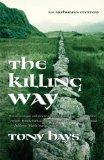Summary | Excerpt | Reviews | Beyond the Book | Read-Alikes | Genres & Themes | Author Bio

This article relates to The Killing Way
No one is sure if there was truly a person named Arthur who was a ruler of
the Britons. Evidence for his existence is scant at best.
The first complete account of the life of King Arthur appeared in Historia
Regum Britanniae (History of the Kings of Britain), written in 1137 -
1138 CE by Geoffrey of Monmouth. Geoffrey surely used historic accounts, but
modern scholars believe that he fabricated much of his text, and that other
parts were a combination of traditions relating to multiple rulers. Regardless
of its inaccuracy, it was very popular and influential. Many manuscript copies
of this document have survived into the 21st century.
The legends surrounding King Arthur are generally divided into those written
before Geoffrey's Historia, which are referred to as pre-Galfridian (from
the Latin for Geoffrey, "Galfrius"), and post-Galfridian. The later stories added Lancelot and the quest for the Holy Grail, and focus less on Arthur. Scholarly opinion is that they are purely fictional. Tony Hays omits references to these post-Galfridian amendments in The Killing Way.
In the Pre-Galfridian traditions, a warrior-ruler named Arthur is mentioned
in two ancient texts. Historia Brittonum (History of the Britons), a 9th
century compilation, lists twelve battles, including the Battle of Mons
Badonicus (Mt. Badon) in which Arthur supposedly took part. Annales Cambriae
(Welsh Annals), 10th century, also links Arthur to the Battle of Mt. Badon (516 – 518 CE). Additionally, it mentions the Battle of Camlann, in which both Arthur and Medraut (Mordred) were killed (537 – 539 CE). Both sources, however, are considered to be of questionable reliability because there are other earlier references to the Battle of Mt. Badon, none of which mention Arthur.
Still earlier tales portray Arthur as a figure of folklore, the leader of a
band of superhuman heroes who protected Britain. At one time this group included pagan gods. Arthur's companions Kay and Bedivere appear in these earliest tales. This version of Arthur emerges in folktales, poems and songs throughout southern Scotland, Wales, the Welsh borders, south-west England, and Brittany. One of the most famous references to him comes from a 6th century collection of Welsh heroic death-songs known as
Y Gododdin.
Tony Hays bases his portrait of the historical Arthur on the work of
Geoffrey
Ashe. Ashe theorizes that the prototype for King Arthur was really Riotomus, a military leader active c. 470 CE. Riotomus is named the "King of the Britons" by Jordanes, a 6th century Roman historian. Ashe further suggests that Riotomus was a title, and may have first referred to Ambrosius Aurelianus, the ruler immediately before or after Arthur.
More interesting links:
Filed under Places, Cultures & Identities
![]() This "beyond the book article" relates to The Killing Way. It originally ran in May 2009 and has been updated for the
March 2010 paperback edition.
Go to magazine.
This "beyond the book article" relates to The Killing Way. It originally ran in May 2009 and has been updated for the
March 2010 paperback edition.
Go to magazine.






Your guide toexceptional books
BookBrowse seeks out and recommends the best in contemporary fiction and nonfiction—books that not only engage and entertain but also deepen our understanding of ourselves and the world around us.